PRMD40030 Construction Portfolio Report: Nottingham Trent University
VerifiedAdded on 2022/10/19
|11
|2684
|285
Report
AI Summary
This report analyzes three different properties: a residential dwelling built after 1990, a framed office/commercial building constructed between 1930 and 1970, and a traditional Victorian commercial property. The report examines deleterious materials used in each building's construction, such as clay bricks and concrete aggregates, and discusses their potential impacts. It also explores sustainable design elements like solar heating systems, glazed curtain walls, and solar shading, evaluating their benefits. Furthermore, the report identifies and evaluates a range of seen or future defects in each building, including tile cracks, pipework issues, and masonry block deterioration. The analysis provides insights into construction practices, material properties, and the importance of sustainable design and maintenance for building longevity.

1. A single residential dwelling house built after 1990
31 Raleigh Street Nottingham NG7 4DH
Figure 1: 31 Raleigh Street Nottingham NG7 4DH. From: https://www.google.com/search?
q=31+Raleigh+Street+Nottingham+NG7+4DH&client
Deleterious material related to the building
The 31 Raleigh Street Nottingham NG7 4DH house was built in 1925. The construction
of the building involved use of clay brick walls. The clay bricks involve use of the slay soil,
extracted from the ground and may contain the deleterious components (Canada, 2014). This is
likely to affect the quality of the bricks when used for construction purposes. These materials
also may contain decayed materials which also may be deleterious components. According to
31 Raleigh Street Nottingham NG7 4DH
Figure 1: 31 Raleigh Street Nottingham NG7 4DH. From: https://www.google.com/search?
q=31+Raleigh+Street+Nottingham+NG7+4DH&client
Deleterious material related to the building
The 31 Raleigh Street Nottingham NG7 4DH house was built in 1925. The construction
of the building involved use of clay brick walls. The clay bricks involve use of the slay soil,
extracted from the ground and may contain the deleterious components (Canada, 2014). This is
likely to affect the quality of the bricks when used for construction purposes. These materials
also may contain decayed materials which also may be deleterious components. According to
Paraphrase This Document
Need a fresh take? Get an instant paraphrase of this document with our AI Paraphraser
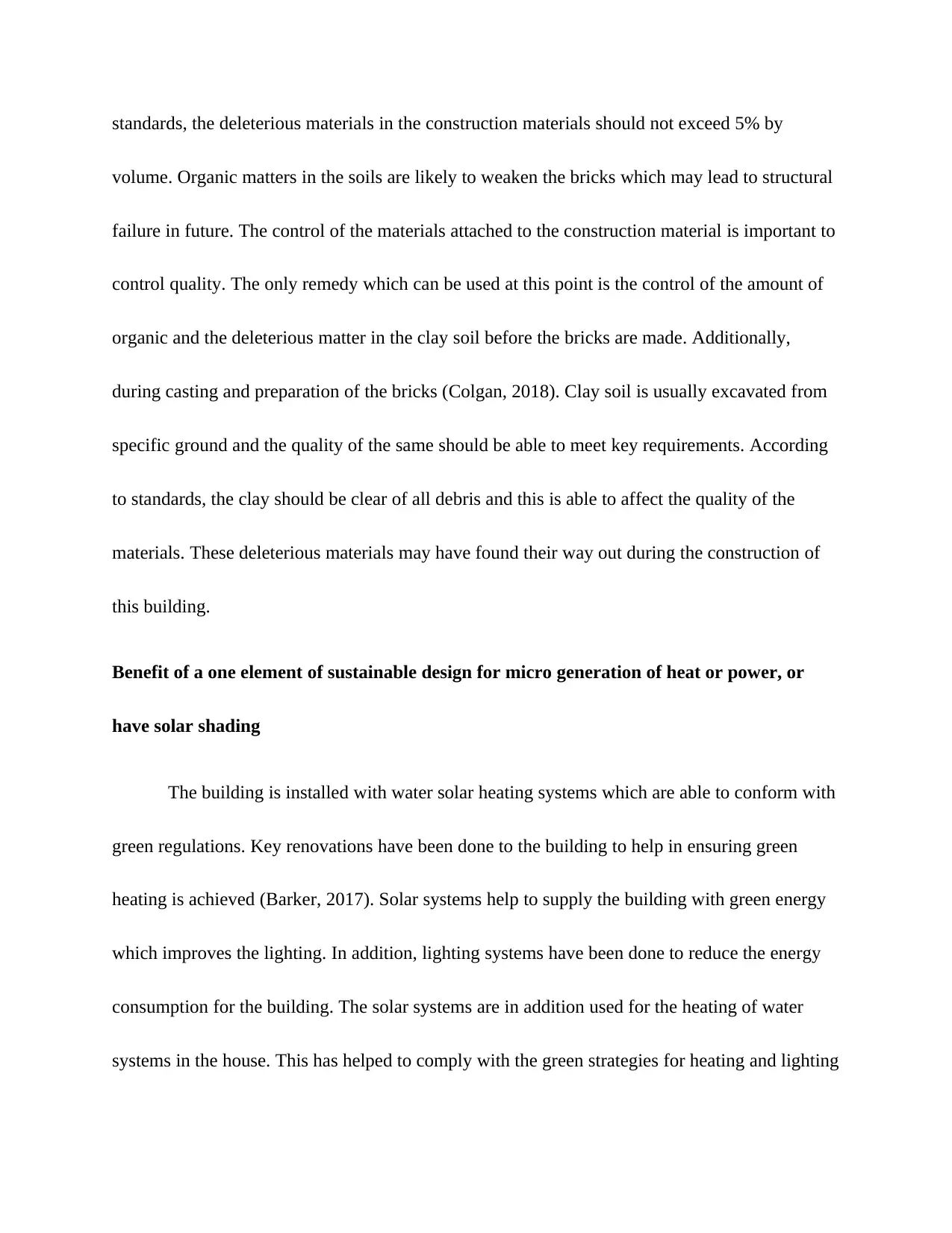
standards, the deleterious materials in the construction materials should not exceed 5% by
volume. Organic matters in the soils are likely to weaken the bricks which may lead to structural
failure in future. The control of the materials attached to the construction material is important to
control quality. The only remedy which can be used at this point is the control of the amount of
organic and the deleterious matter in the clay soil before the bricks are made. Additionally,
during casting and preparation of the bricks (Colgan, 2018). Clay soil is usually excavated from
specific ground and the quality of the same should be able to meet key requirements. According
to standards, the clay should be clear of all debris and this is able to affect the quality of the
materials. These deleterious materials may have found their way out during the construction of
this building.
Benefit of a one element of sustainable design for micro generation of heat or power, or
have solar shading
The building is installed with water solar heating systems which are able to conform with
green regulations. Key renovations have been done to the building to help in ensuring green
heating is achieved (Barker, 2017). Solar systems help to supply the building with green energy
which improves the lighting. In addition, lighting systems have been done to reduce the energy
consumption for the building. The solar systems are in addition used for the heating of water
systems in the house. This has helped to comply with the green strategies for heating and lighting
volume. Organic matters in the soils are likely to weaken the bricks which may lead to structural
failure in future. The control of the materials attached to the construction material is important to
control quality. The only remedy which can be used at this point is the control of the amount of
organic and the deleterious matter in the clay soil before the bricks are made. Additionally,
during casting and preparation of the bricks (Colgan, 2018). Clay soil is usually excavated from
specific ground and the quality of the same should be able to meet key requirements. According
to standards, the clay should be clear of all debris and this is able to affect the quality of the
materials. These deleterious materials may have found their way out during the construction of
this building.
Benefit of a one element of sustainable design for micro generation of heat or power, or
have solar shading
The building is installed with water solar heating systems which are able to conform with
green regulations. Key renovations have been done to the building to help in ensuring green
heating is achieved (Barker, 2017). Solar systems help to supply the building with green energy
which improves the lighting. In addition, lighting systems have been done to reduce the energy
consumption for the building. The solar systems are in addition used for the heating of water
systems in the house. This has helped to comply with the green strategies for heating and lighting
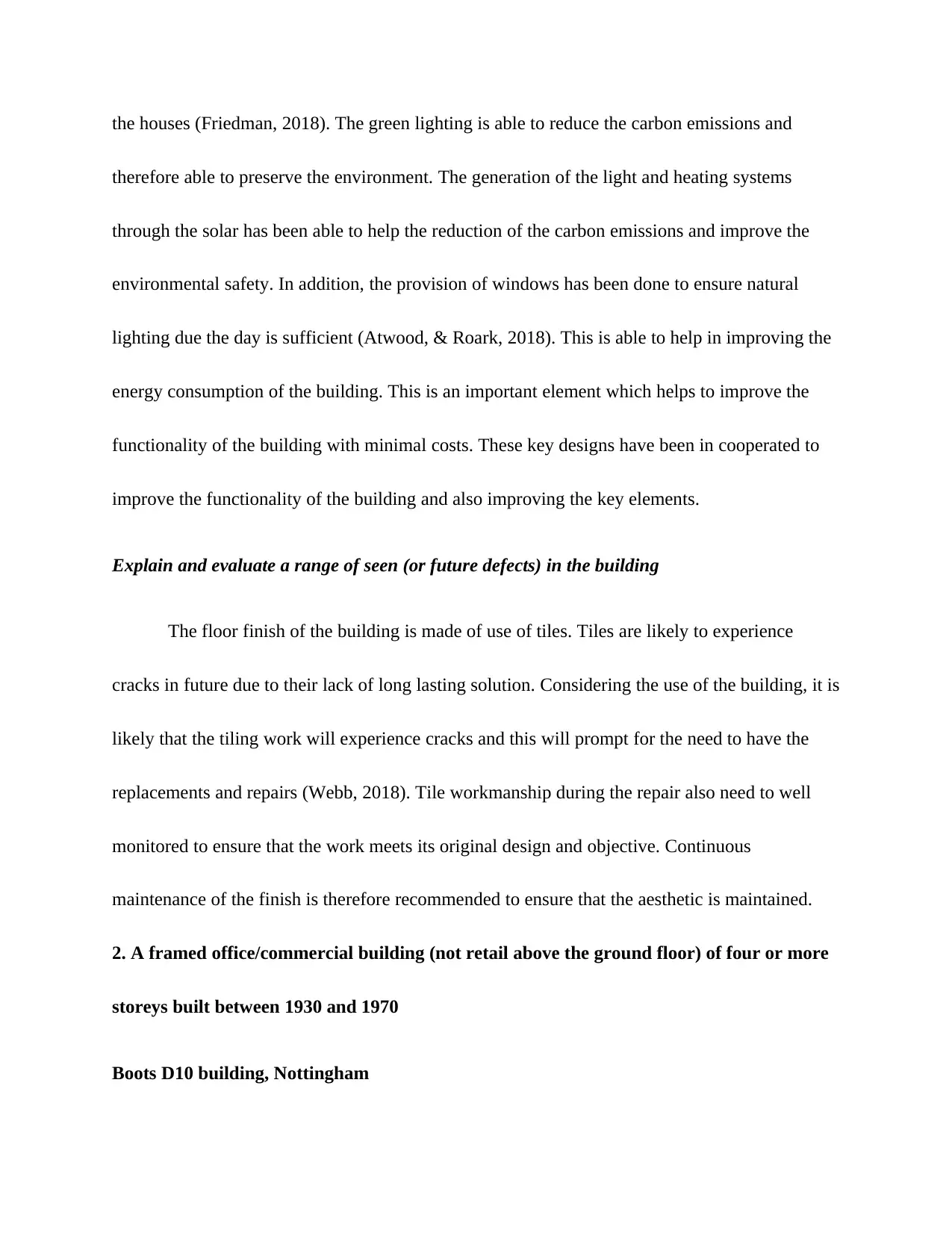
the houses (Friedman, 2018). The green lighting is able to reduce the carbon emissions and
therefore able to preserve the environment. The generation of the light and heating systems
through the solar has been able to help the reduction of the carbon emissions and improve the
environmental safety. In addition, the provision of windows has been done to ensure natural
lighting due the day is sufficient (Atwood, & Roark, 2018). This is able to help in improving the
energy consumption of the building. This is an important element which helps to improve the
functionality of the building with minimal costs. These key designs have been in cooperated to
improve the functionality of the building and also improving the key elements.
Explain and evaluate a range of seen (or future defects) in the building
The floor finish of the building is made of use of tiles. Tiles are likely to experience
cracks in future due to their lack of long lasting solution. Considering the use of the building, it is
likely that the tiling work will experience cracks and this will prompt for the need to have the
replacements and repairs (Webb, 2018). Tile workmanship during the repair also need to well
monitored to ensure that the work meets its original design and objective. Continuous
maintenance of the finish is therefore recommended to ensure that the aesthetic is maintained.
2. A framed office/commercial building (not retail above the ground floor) of four or more
storeys built between 1930 and 1970
Boots D10 building, Nottingham
therefore able to preserve the environment. The generation of the light and heating systems
through the solar has been able to help the reduction of the carbon emissions and improve the
environmental safety. In addition, the provision of windows has been done to ensure natural
lighting due the day is sufficient (Atwood, & Roark, 2018). This is able to help in improving the
energy consumption of the building. This is an important element which helps to improve the
functionality of the building with minimal costs. These key designs have been in cooperated to
improve the functionality of the building and also improving the key elements.
Explain and evaluate a range of seen (or future defects) in the building
The floor finish of the building is made of use of tiles. Tiles are likely to experience
cracks in future due to their lack of long lasting solution. Considering the use of the building, it is
likely that the tiling work will experience cracks and this will prompt for the need to have the
replacements and repairs (Webb, 2018). Tile workmanship during the repair also need to well
monitored to ensure that the work meets its original design and objective. Continuous
maintenance of the finish is therefore recommended to ensure that the aesthetic is maintained.
2. A framed office/commercial building (not retail above the ground floor) of four or more
storeys built between 1930 and 1970
Boots D10 building, Nottingham
⊘ This is a preview!⊘
Do you want full access?
Subscribe today to unlock all pages.

Trusted by 1+ million students worldwide

Deleterious material related to the building
One of the key material which was used in construction of the Boots D10 building in
Nottingham is structural concrete (Watt, 2010). The constituents in the aggregates for the
concrete may include the deleterious components which may affect the quality and workability
and the long term performance of the concrete in future. Aggregates for the concrete are gotten
from different physical sites and grounds which have different organic components. Decayed
mater may get attached to the aggregates and this will mean that the concrete will have the
composition of the identified organic matter. The only remedy which can be used at this point is
the control of the amount of organic and the deleterious matter in the aggregates. The standards
identify that the amount of the deleterious matter should not exceed 5% according to IS 383-
1970. Additionally, during casting and preparation of the concrete, clay and other fine materials
may have found its way to the concrete or the aggregate surface due to the storage. The clay acts
like a coating and therefore able to affect the bonding between cement and the aggregates
material. This is the end is able to weaken the bond which was to be achieved and therefore
affecting the strength of the concrete (Holt 2014). These deleterious materials may have found
their way out during the construction of this building. Nevertheless, due to the durability which
has been achieved, it can be concluded that the control of the deleterious materials in the
concrete for the building was well monitored.
One of the key material which was used in construction of the Boots D10 building in
Nottingham is structural concrete (Watt, 2010). The constituents in the aggregates for the
concrete may include the deleterious components which may affect the quality and workability
and the long term performance of the concrete in future. Aggregates for the concrete are gotten
from different physical sites and grounds which have different organic components. Decayed
mater may get attached to the aggregates and this will mean that the concrete will have the
composition of the identified organic matter. The only remedy which can be used at this point is
the control of the amount of organic and the deleterious matter in the aggregates. The standards
identify that the amount of the deleterious matter should not exceed 5% according to IS 383-
1970. Additionally, during casting and preparation of the concrete, clay and other fine materials
may have found its way to the concrete or the aggregate surface due to the storage. The clay acts
like a coating and therefore able to affect the bonding between cement and the aggregates
material. This is the end is able to weaken the bond which was to be achieved and therefore
affecting the strength of the concrete (Holt 2014). These deleterious materials may have found
their way out during the construction of this building. Nevertheless, due to the durability which
has been achieved, it can be concluded that the control of the deleterious materials in the
concrete for the building was well monitored.
Paraphrase This Document
Need a fresh take? Get an instant paraphrase of this document with our AI Paraphraser
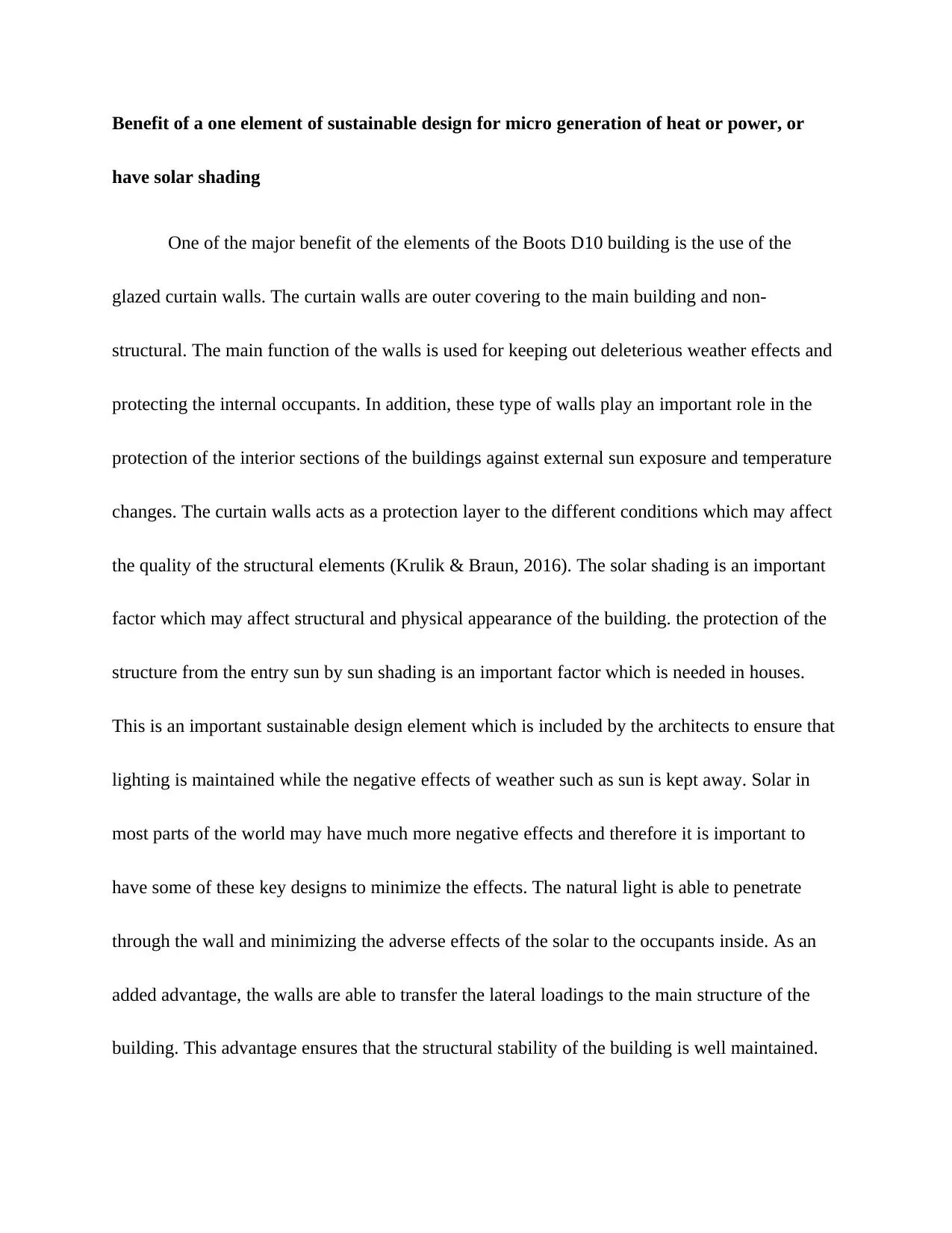
Benefit of a one element of sustainable design for micro generation of heat or power, or
have solar shading
One of the major benefit of the elements of the Boots D10 building is the use of the
glazed curtain walls. The curtain walls are outer covering to the main building and non-
structural. The main function of the walls is used for keeping out deleterious weather effects and
protecting the internal occupants. In addition, these type of walls play an important role in the
protection of the interior sections of the buildings against external sun exposure and temperature
changes. The curtain walls acts as a protection layer to the different conditions which may affect
the quality of the structural elements (Krulik & Braun, 2016). The solar shading is an important
factor which may affect structural and physical appearance of the building. the protection of the
structure from the entry sun by sun shading is an important factor which is needed in houses.
This is an important sustainable design element which is included by the architects to ensure that
lighting is maintained while the negative effects of weather such as sun is kept away. Solar in
most parts of the world may have much more negative effects and therefore it is important to
have some of these key designs to minimize the effects. The natural light is able to penetrate
through the wall and minimizing the adverse effects of the solar to the occupants inside. As an
added advantage, the walls are able to transfer the lateral loadings to the main structure of the
building. This advantage ensures that the structural stability of the building is well maintained.
have solar shading
One of the major benefit of the elements of the Boots D10 building is the use of the
glazed curtain walls. The curtain walls are outer covering to the main building and non-
structural. The main function of the walls is used for keeping out deleterious weather effects and
protecting the internal occupants. In addition, these type of walls play an important role in the
protection of the interior sections of the buildings against external sun exposure and temperature
changes. The curtain walls acts as a protection layer to the different conditions which may affect
the quality of the structural elements (Krulik & Braun, 2016). The solar shading is an important
factor which may affect structural and physical appearance of the building. the protection of the
structure from the entry sun by sun shading is an important factor which is needed in houses.
This is an important sustainable design element which is included by the architects to ensure that
lighting is maintained while the negative effects of weather such as sun is kept away. Solar in
most parts of the world may have much more negative effects and therefore it is important to
have some of these key designs to minimize the effects. The natural light is able to penetrate
through the wall and minimizing the adverse effects of the solar to the occupants inside. As an
added advantage, the walls are able to transfer the lateral loadings to the main structure of the
building. This advantage ensures that the structural stability of the building is well maintained.
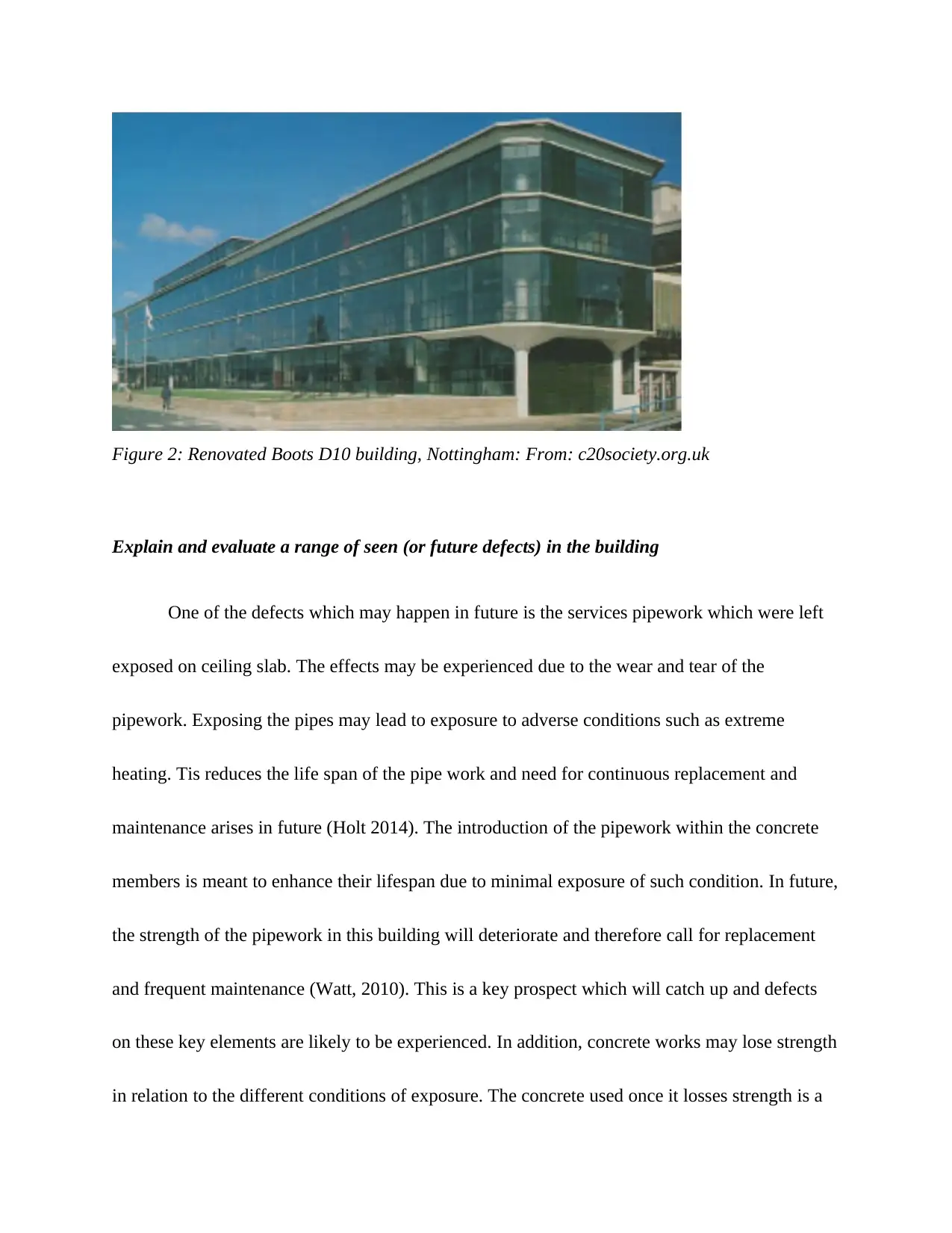
Figure 2: Renovated Boots D10 building, Nottingham: From: c20society.org.uk
Explain and evaluate a range of seen (or future defects) in the building
One of the defects which may happen in future is the services pipework which were left
exposed on ceiling slab. The effects may be experienced due to the wear and tear of the
pipework. Exposing the pipes may lead to exposure to adverse conditions such as extreme
heating. Tis reduces the life span of the pipe work and need for continuous replacement and
maintenance arises in future (Holt 2014). The introduction of the pipework within the concrete
members is meant to enhance their lifespan due to minimal exposure of such condition. In future,
the strength of the pipework in this building will deteriorate and therefore call for replacement
and frequent maintenance (Watt, 2010). This is a key prospect which will catch up and defects
on these key elements are likely to be experienced. In addition, concrete works may lose strength
in relation to the different conditions of exposure. The concrete used once it losses strength is a
Explain and evaluate a range of seen (or future defects) in the building
One of the defects which may happen in future is the services pipework which were left
exposed on ceiling slab. The effects may be experienced due to the wear and tear of the
pipework. Exposing the pipes may lead to exposure to adverse conditions such as extreme
heating. Tis reduces the life span of the pipe work and need for continuous replacement and
maintenance arises in future (Holt 2014). The introduction of the pipework within the concrete
members is meant to enhance their lifespan due to minimal exposure of such condition. In future,
the strength of the pipework in this building will deteriorate and therefore call for replacement
and frequent maintenance (Watt, 2010). This is a key prospect which will catch up and defects
on these key elements are likely to be experienced. In addition, concrete works may lose strength
in relation to the different conditions of exposure. The concrete used once it losses strength is a
⊘ This is a preview!⊘
Do you want full access?
Subscribe today to unlock all pages.

Trusted by 1+ million students worldwide
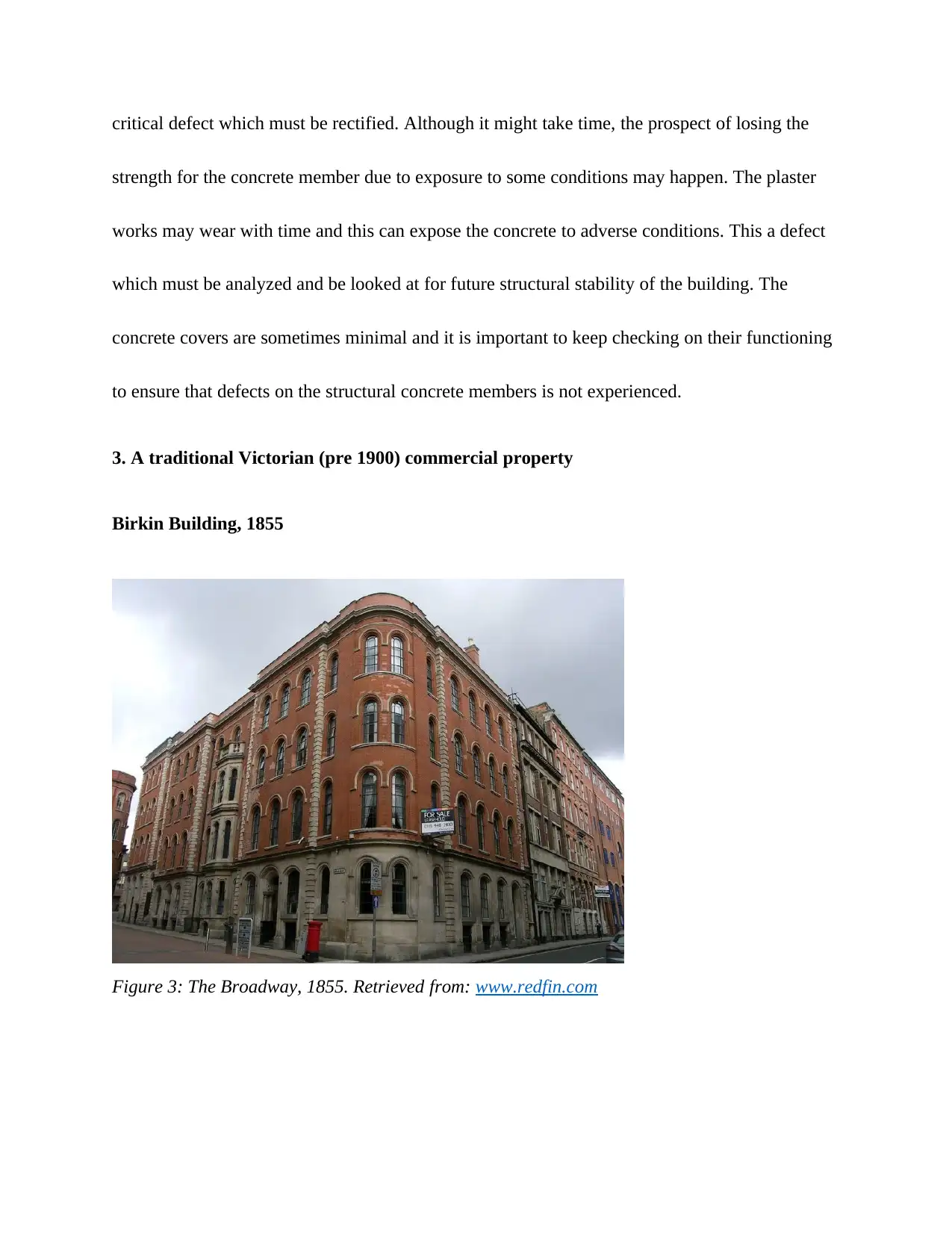
critical defect which must be rectified. Although it might take time, the prospect of losing the
strength for the concrete member due to exposure to some conditions may happen. The plaster
works may wear with time and this can expose the concrete to adverse conditions. This a defect
which must be analyzed and be looked at for future structural stability of the building. The
concrete covers are sometimes minimal and it is important to keep checking on their functioning
to ensure that defects on the structural concrete members is not experienced.
3. A traditional Victorian (pre 1900) commercial property
Birkin Building, 1855
Figure 3: The Broadway, 1855. Retrieved from: www.redfin.com
strength for the concrete member due to exposure to some conditions may happen. The plaster
works may wear with time and this can expose the concrete to adverse conditions. This a defect
which must be analyzed and be looked at for future structural stability of the building. The
concrete covers are sometimes minimal and it is important to keep checking on their functioning
to ensure that defects on the structural concrete members is not experienced.
3. A traditional Victorian (pre 1900) commercial property
Birkin Building, 1855
Figure 3: The Broadway, 1855. Retrieved from: www.redfin.com
Paraphrase This Document
Need a fresh take? Get an instant paraphrase of this document with our AI Paraphraser

Figure 4: Entrance of The Broadway, 1855 Retrieved from: www.redfin.com
Deleterious material related to the building
The Broadway building was built in 1855 and has the traditional Victorian Design. This
is a three storey building (Margulies, 2015). Recycling of materials was much encouraged during
the construction of the Broadways Building. Recycled materials may be hazards to the health of
the people or even affect the strength of the members of the building (Dixon, 2014). These
recycled materials can therefore be considered deleterious if not well purified before they are
reused. Water for example is one of the most material which was highly recycled. Water is able
to combine with many organic and inorganic matter which can be harmful to the health of those
handling them. Many of the chemicals are able to dissolve in water and therefore changing the
chemical composition (Broadway House, 2014 and Mcguinness, Barslund, & Ibsen, 2012).
When used in construction, the elements which are in water will react with aggregates and even
Deleterious material related to the building
The Broadway building was built in 1855 and has the traditional Victorian Design. This
is a three storey building (Margulies, 2015). Recycling of materials was much encouraged during
the construction of the Broadways Building. Recycled materials may be hazards to the health of
the people or even affect the strength of the members of the building (Dixon, 2014). These
recycled materials can therefore be considered deleterious if not well purified before they are
reused. Water for example is one of the most material which was highly recycled. Water is able
to combine with many organic and inorganic matter which can be harmful to the health of those
handling them. Many of the chemicals are able to dissolve in water and therefore changing the
chemical composition (Broadway House, 2014 and Mcguinness, Barslund, & Ibsen, 2012).
When used in construction, the elements which are in water will react with aggregates and even

cement to form other compounds. These compounds can be detrimental in affecting the strength
of the structure. For instance, the reaction may accelerate the reinforcement rusting and therefore
affecting the strength of the reinforced concrete members. The water recycling was therefore one
of the common practice during the construction of this building (Worden, 2014). As part of the
construction material, this would be considered a deleterious material if proper chemical analysis
was not carried to determine the elements present on water before being used for construction.
Recycled water can therefore be deleterious and proper analysis is required before the reuse.
Benefit of a one element of sustainable design for micro generation of heat or power, or
have solar shading
Sustainable designed is aimed at achieving the green factors of the building. This can be
done and achieved by considering different design elements which have been critical for it to be
considered as a sustainable design (Locker, 2014). To achieve the sustainable design, the
building has used the glass solar shading. This is the technology which has been improvised to
ensure that direct sunlight does not penetrate to the building and therefore affecting the residents
(Krulik & Braun, 2016). According to the use of this building, solar shading was required to
ensure that the occupants in the building. In addition, the windows are glazed as part of the
sustainable design measure employed in the construction of this building. The facades are able to
of the structure. For instance, the reaction may accelerate the reinforcement rusting and therefore
affecting the strength of the reinforced concrete members. The water recycling was therefore one
of the common practice during the construction of this building (Worden, 2014). As part of the
construction material, this would be considered a deleterious material if proper chemical analysis
was not carried to determine the elements present on water before being used for construction.
Recycled water can therefore be deleterious and proper analysis is required before the reuse.
Benefit of a one element of sustainable design for micro generation of heat or power, or
have solar shading
Sustainable designed is aimed at achieving the green factors of the building. This can be
done and achieved by considering different design elements which have been critical for it to be
considered as a sustainable design (Locker, 2014). To achieve the sustainable design, the
building has used the glass solar shading. This is the technology which has been improvised to
ensure that direct sunlight does not penetrate to the building and therefore affecting the residents
(Krulik & Braun, 2016). According to the use of this building, solar shading was required to
ensure that the occupants in the building. In addition, the windows are glazed as part of the
sustainable design measure employed in the construction of this building. The facades are able to
⊘ This is a preview!⊘
Do you want full access?
Subscribe today to unlock all pages.

Trusted by 1+ million students worldwide
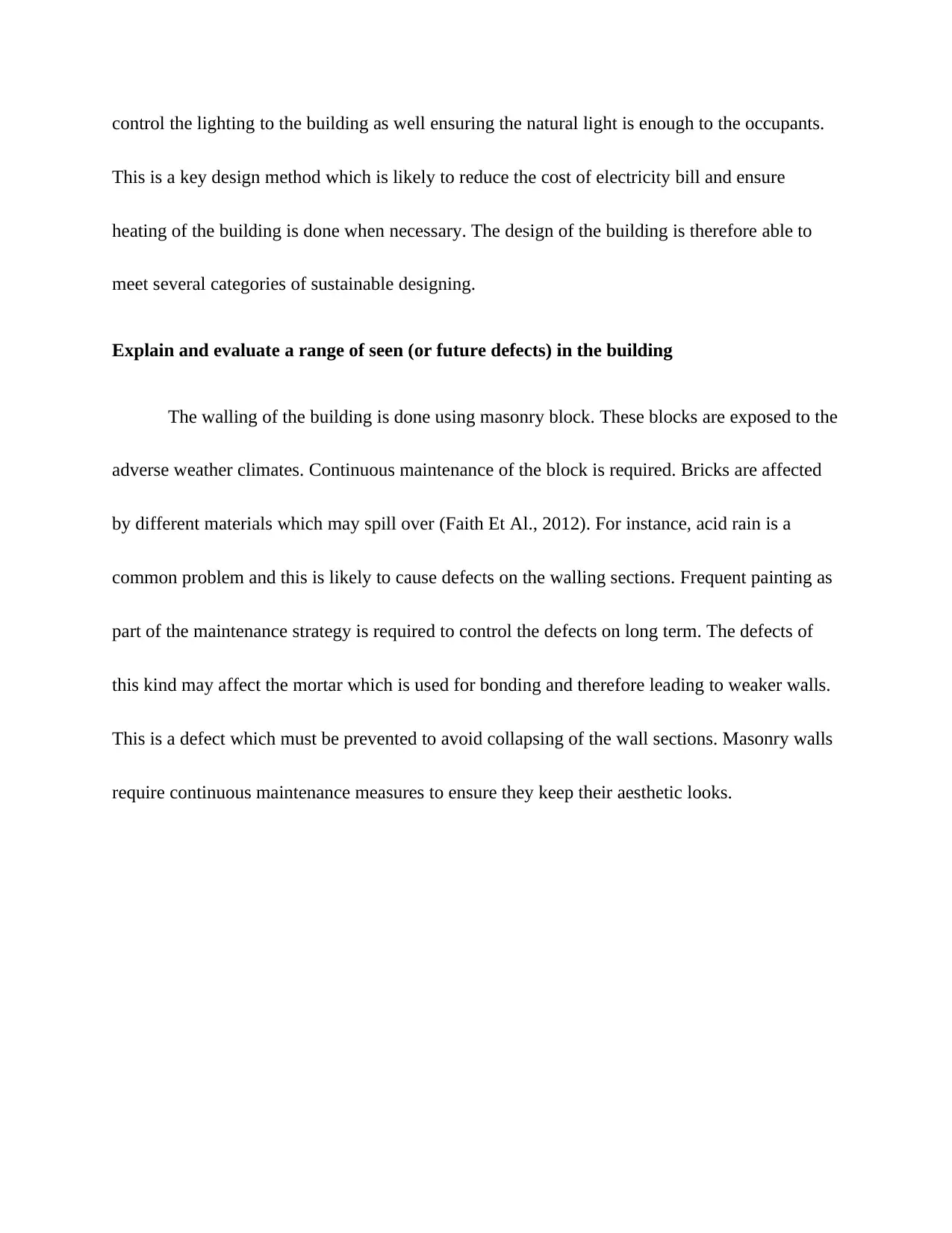
control the lighting to the building as well ensuring the natural light is enough to the occupants.
This is a key design method which is likely to reduce the cost of electricity bill and ensure
heating of the building is done when necessary. The design of the building is therefore able to
meet several categories of sustainable designing.
Explain and evaluate a range of seen (or future defects) in the building
The walling of the building is done using masonry block. These blocks are exposed to the
adverse weather climates. Continuous maintenance of the block is required. Bricks are affected
by different materials which may spill over (Faith Et Al., 2012). For instance, acid rain is a
common problem and this is likely to cause defects on the walling sections. Frequent painting as
part of the maintenance strategy is required to control the defects on long term. The defects of
this kind may affect the mortar which is used for bonding and therefore leading to weaker walls.
This is a defect which must be prevented to avoid collapsing of the wall sections. Masonry walls
require continuous maintenance measures to ensure they keep their aesthetic looks.
This is a key design method which is likely to reduce the cost of electricity bill and ensure
heating of the building is done when necessary. The design of the building is therefore able to
meet several categories of sustainable designing.
Explain and evaluate a range of seen (or future defects) in the building
The walling of the building is done using masonry block. These blocks are exposed to the
adverse weather climates. Continuous maintenance of the block is required. Bricks are affected
by different materials which may spill over (Faith Et Al., 2012). For instance, acid rain is a
common problem and this is likely to cause defects on the walling sections. Frequent painting as
part of the maintenance strategy is required to control the defects on long term. The defects of
this kind may affect the mortar which is used for bonding and therefore leading to weaker walls.
This is a defect which must be prevented to avoid collapsing of the wall sections. Masonry walls
require continuous maintenance measures to ensure they keep their aesthetic looks.
Paraphrase This Document
Need a fresh take? Get an instant paraphrase of this document with our AI Paraphraser

References
Atwood, A., & Roark, R. (2018). Not interesting: on the limits of criticism in architecture.
[Novato, California] : Applied Research and Design Publishing
Barker, A. (2017). 1930s Thames: the goldfield town revisited. [Thames, New Zealand] : [Althea
Baker].
Broadway House. (2014). Broadway House book sale catalogs. London, Broadway House.
Canada. (2014). Cornwall. [Ottawa], MCE.
Colgan, J. (2018). Christmas at Little Beach Street Bakery. Oxford : ISIS
Dixon, K. J. (2014). Historical Archaeologies of the American West. Journal of Archaeological
Research. 22, 177-228.
Faith, R., Davis, J., Healey, J., Murphy, A. L., Bradley, K., Taylor, J., & Brownlow, G. (2012).
Review of periodical literature published in 2010. The Economic History Review. 65, 322-375.
Friedman, A. (2018). Fundamentals of sustainable urban renewal in small and mid-sized towns.
https://search.ebscohost.com/login.aspx?
direct=true&scope=site&db=nlebk&db=nlabk&AN=18160
Holt D., G. (2014). Industrial innovation: case study of the Claerwen dam. Built Environment
Project and Asset Management. 4, 146-165.
Krulik, N. E., & Braun, S. (2016). Broadway doggie. New York, New York : Grosset & Dunlap,
an imprint of Penguin Random House
Locker, A. (2014). The social history of coarse angling in England AD 1750-1950.
Anthropozoologica. 49, 99-107.
Margulies, D. (2015). The country house. New York : Theatre Communications Group
Mcguinness, F., Barslund, C., & Ibsen, H. (2012). A doll's house. London, Faber.
Watt, K. (2010). Fifty buildings, 50 years modern architecture in east Midlands. Lincoln, RIBA
East Midlands.
Webb, K. (2018). The Past Is Present. http://search.ebscohost.com/login.aspx?
direct=true&scope=site&db=nlebk&db=nlabk&AN=1801637.
Worden, S. (2014). The Earth Sciences and Creative Practice. Nanotechnology; Information
Science Reference; Chapter 62; p. 1342-1361
Atwood, A., & Roark, R. (2018). Not interesting: on the limits of criticism in architecture.
[Novato, California] : Applied Research and Design Publishing
Barker, A. (2017). 1930s Thames: the goldfield town revisited. [Thames, New Zealand] : [Althea
Baker].
Broadway House. (2014). Broadway House book sale catalogs. London, Broadway House.
Canada. (2014). Cornwall. [Ottawa], MCE.
Colgan, J. (2018). Christmas at Little Beach Street Bakery. Oxford : ISIS
Dixon, K. J. (2014). Historical Archaeologies of the American West. Journal of Archaeological
Research. 22, 177-228.
Faith, R., Davis, J., Healey, J., Murphy, A. L., Bradley, K., Taylor, J., & Brownlow, G. (2012).
Review of periodical literature published in 2010. The Economic History Review. 65, 322-375.
Friedman, A. (2018). Fundamentals of sustainable urban renewal in small and mid-sized towns.
https://search.ebscohost.com/login.aspx?
direct=true&scope=site&db=nlebk&db=nlabk&AN=18160
Holt D., G. (2014). Industrial innovation: case study of the Claerwen dam. Built Environment
Project and Asset Management. 4, 146-165.
Krulik, N. E., & Braun, S. (2016). Broadway doggie. New York, New York : Grosset & Dunlap,
an imprint of Penguin Random House
Locker, A. (2014). The social history of coarse angling in England AD 1750-1950.
Anthropozoologica. 49, 99-107.
Margulies, D. (2015). The country house. New York : Theatre Communications Group
Mcguinness, F., Barslund, C., & Ibsen, H. (2012). A doll's house. London, Faber.
Watt, K. (2010). Fifty buildings, 50 years modern architecture in east Midlands. Lincoln, RIBA
East Midlands.
Webb, K. (2018). The Past Is Present. http://search.ebscohost.com/login.aspx?
direct=true&scope=site&db=nlebk&db=nlabk&AN=1801637.
Worden, S. (2014). The Earth Sciences and Creative Practice. Nanotechnology; Information
Science Reference; Chapter 62; p. 1342-1361
1 out of 11
Related Documents
Your All-in-One AI-Powered Toolkit for Academic Success.
+13062052269
info@desklib.com
Available 24*7 on WhatsApp / Email
![[object Object]](/_next/static/media/star-bottom.7253800d.svg)
Unlock your academic potential
Copyright © 2020–2025 A2Z Services. All Rights Reserved. Developed and managed by ZUCOL.





